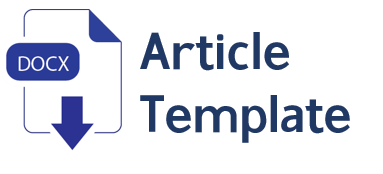Measuring Employee Work Stress Level on Cyberloafing Behavior
DOI:
https://doi.org/10.30741/wiga.v12i1.647Abstract
The drastic increase in the use of information technology ranging from computers, laptops and smartphones tends to allow for a wide-scale transformation in human life. Coupled with a very big change, namely the emergence of the internet in the midst of society, where all information can be presented according to the needs of its users, and users are no longer limited by age, especially from educational and work backgrounds. The purpose of this research is to find a solution to the problem which will later provide an overview and empirical evidence of the problem of cyberloafing behavior carried out by employees of the Village Government Office in Lumajang Regency. The data collection technique in this research questionnaire is to use an online questionnaire to 80 respondents at the Village Government Office in Lumajang Regency. Management of data in this study using the help of the IBM SPSS Statistics Version 24 program. The analysis used is multiple linear regression analysis. The results showed that: 1) role conflict had a significant effect on cyberloafing behavior, 2) role ambiguity had no significant effect on cyberloafing behavior, 3) role overload had no significant effect on cyberloafing behavior.
Downloads
References
Ahmad, Parawansa, D. A. S., & Jusni. (2019). Pengaruh Role Ambiguity, Role Conflict dan Role Overload terhadap Kinerja Pegawai Dimediasi Perilaku Cyberloafing pada Biro Akademik dan Umum Universitas Sulawesi Barat. Hasanuddin Journal of Business Strategy (HJBS), 1(1).
Ardilasari, N., & Firmanto, A. (2017). Hubungan Self Control dan Perilaku Cyberloafing pada Pegawai Negeri Sipil. Ilmiah Psikologi Terapan, 5(1), 19-39.
Askew, K., Buckner, J. E., Taing, M. U., Ilie, A., Bauer, J. A., & Coovert, M. D. (2014). Explaining Cyberloafing: the Role of the Theory of Planned Behavior. Computers in Human Behavior, 36, 510–519. doi: 10.1016/j.chb.2014.04.006
Astri, Y., & Zahreni, S. (2017). Pengaruh Iklim Organisasi terhadap Perilaku Cyberloafing pada Karyawan PT X. Jurnal Pemikiran & Penelitian Psikologi, 13(1), 16-26. doi: www.jurnal.usu.ac.id/psikologia
Fitriani, D. (2018). Analisis Pengaruh Penggunaan Teknologi Informasi terhadap Kinerja Karyawan PT. Asuransi Jiwasraya Pontianak. Cogito Smart Journal, 4(1), 160-170.
Hardiani, W. A. A., Rahardja, E., & Yuniawan, A. (2017). Effect of Role Conflict and Role Overload to Burnout and its Impact on Cyberloafing (Study on PT PLN (Persero) Pusat Manajemen Konstruksi). Jurnal Bisnis STRATEGI, 26(2), 89-99.
Henle, C. A. (2008). The Interaction of Work Stressors and Organizational Sanctions on Cyberloafing. JOURNAL OF MANAGERIAL ISSUES, XX(3), 383-400.
Herdiati, M. F., Sujoso, A. D. P., & Hartanti, R. I. (2015). Pengaruh Stresor Kerja dan Persepsi Sanksi Organisasi terhadap Perilaku Cyberloafing di Universitas Jember. e-Jurnal Pustaka Kesehatan, 3(1), 179-185.
Herlianto, A. W. (2012). Pengaruh Stres Kerja pada Cyberloafing. Ilmiah Mahasiswa Manajemen, 1(2), 1-5.
Hurriyati, D. (2017). Analisis Faktor-Faktor yang mempengaruhi Perilaku Cyberloafing pada Pegawai Negeri Dinas Pekerjaan Umum Kota Palembang. Jurnal Ilmiah PSYCHE, 11(2), 75-86.
Lonteng, E., Kindangen, P., & Tumewu, F. (2019). Analisa Konflik Peran dan Ambiguitas Peran Terhadap Cyberloafing Di PT. Bank Sulutgo Manado.
Marsal, A., & Hidayati, F. (2018). Pengaruh Penggunaan Media Sosial terhadap Kinerja Pegawai di Lingkungan Uin Suska Riau. Jurnal Ilmiah Rekayasa dan Manajemen Sistem Informasi, 4(1), 91-98.
Nydia, N., & Pareke, F. J. (2019). Dinamika Peran dan Cyberloafing. Managament Insight: Jurnal Ilmiah Manajemen, 14(2), 138-146. doi: https://doi.org/10.33369/insight.14.2.138-146
Prasad, S., Lim, V. K. G., & Chen, D. J. Q. (2010). Self-Regulation, Individual Characteristics and Cyberloafing. AIS Electronic Library (AISeL), 159, 1640-1648.
Putra, E. Y., & Nurtjahjanti, H. (2019). Hubungan antara Komitmen Organisasi dengan Cyberloafing pada Pegawai Fakultas Teknik Universitas Diponegoro. Jurnal Empati, 8(2), 147-152.
Ramadhan, V. A., & Sari, E. Y. D. (2018). Perilaku Cyberloafing pada Pekerja Perempuan. Jurnal Psikologi Integratif, 6(2), 213-224.
Sari, S. L., & Ratnaningsih, I. Z. (2018). Hubungan antara Kontrol Diri dengan Intensi Cyberloafing pada Pegawai Dinas X Provinsi Jawa Tengah. Jurnal Empati, 7(2), 160-166.
Sawitri, H. S. R. (2012). Role of Internet Experience in Moderating Influence of Work Stressor on Cyberloafing. Procedia - Social and Behavioral Sciences, 57, 320 – 324. doi: 10.1016/j.sbspro.2012.09.1192
Simanjuntak, E., Fajrianthi, Purwono, U., & Ardi, R. (2019). Skala Cyberslacking pada Mahasiswa. Jurnal Psikologi, 18(1), 55-68.
Sofyanty, D. (2019). Perilaku Cyberloafing Ditinjau Dari Psychological Capital dan Adversity Quotient. Widya Cipta: Jurnal Sekretari dan Manajemen, 3(2), 186-194. doi: 10.31294/widyacipta.v3i1
Tanjung, S., Putra, A. A., & Aiyuda, N. (2019). Locus of Control terhadap Perilaku Cyberloafing pada karyawan Pemerintahan X Daerah Riau. PSYCHOPOLYTAN (Jurnal Psikologi), 2(2), 117-123.
Varghese, L., & Barber, L. K. (2017). A preliminary study exploring moderating effects of role stressors on the relationship between Big Five personality traits and workplace cyberloafing. Cyberpsychology: Journal of Psychosocial Research on Cyberspace, 11(4), 1-15. doi: 10.5817/cp2017-4-4
Yılmaz, F. G. K., Yılmaz, R., Ozturk, H. T., Sezer, B., & Karademir, T. (2015). Cyberloafing as a barrier to the successful integration of information and communication technologies into teaching and learning environments. homepage, 45, 290–298. doi: 10.1016/j.chb.2014.12.023
Downloads
Published
How to Cite
Issue
Section
License
Copyright (c) 2022 Danang Wikan Carito, Suwignnyo Widagdo, Muhaimin Dimyati

This work is licensed under a Creative Commons Attribution-ShareAlike 4.0 International License.










